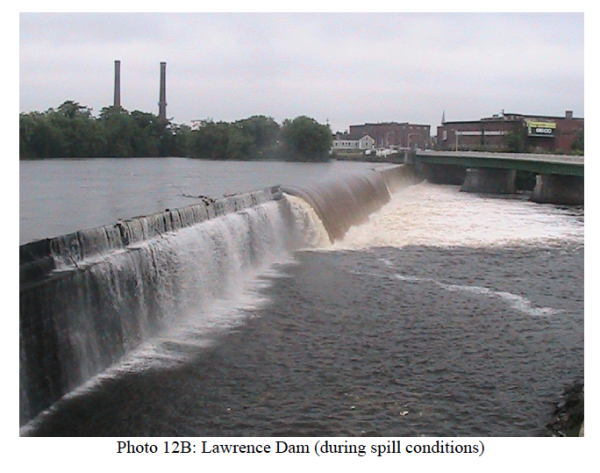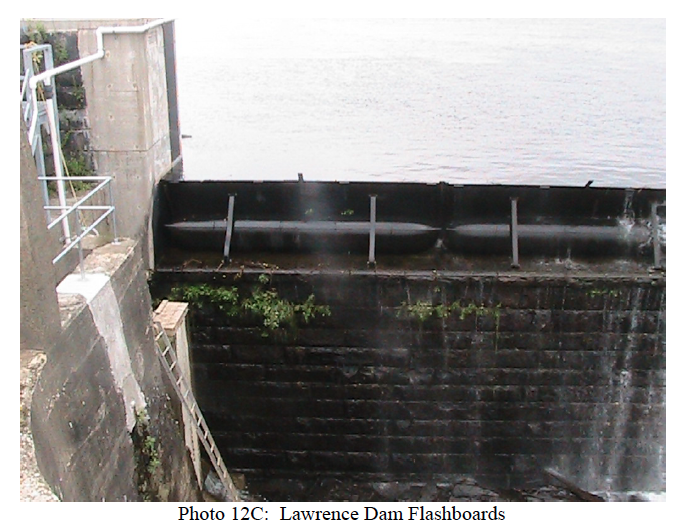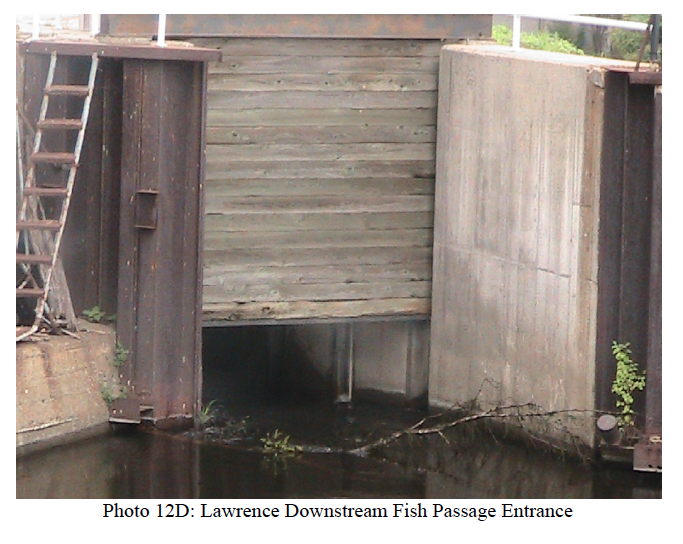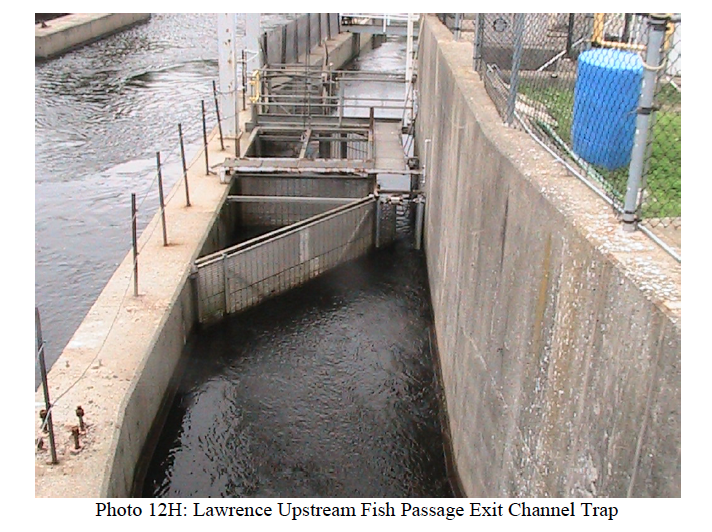LIHI Certificate #121 – Lawrence Project, Massachusetts





| Project Name | Lawrence |
| LIHI Certificate No. | 121 |
| LIHI Certificate Term |
March 13, 2020 – March 12, 2030 |
| Owner | Essex Company, LLC a subsidiary of LS Power/ Patriot Hydro, LLC |
| State | Massachusetts |
| Location | Located at river mile 31 on the Merrimack River in the city of Lawrence, Essex County, MA. |
| Installed Capacity | 16.8 MW |
| Average Annual Generation | 64,600 MWh |
| Facility Type | Run-of-river |
| FERC No. | P-2800 issued in 1978, expires 11/30/2028 |
The Lawrence Project is located on the Merrimack River in the city of Lawrence, Essex County, Massachusetts. The Merrimack River begins at the confluence of the Winnipesaukee and Pemigewasset rivers in Franklin, New Hampshire. It then flows generally south through New Hampshire and then northeast in Massachusetts towards the town of Newburyport, where it empties into the Atlantic Ocean. The Merrimack River is approximately 117 miles long and has a drainage area of approximately 5,015 square miles. The river and its tributaries have many hydroelectric projects, reflecting the significant number of industrial activities that originally took place in the towns along the river. Lawrence’s Essex Dam is the first dam upstream of the Atlantic Ocean on the river, located 29 miles from the confluence in Newburyport, and about 11 miles downstream of the Lowell Project (LIHI #142).
Essex Dam is a 33-foot-high, 900-foot-long dam of rubble masonry construction with a 5-foot-high pneumatic crest gate system. The South Canal is approximately 35 feet wide and 10 feet deep, originating at the south abutment of the dam and generally paralleling the riverbed, below the dam for a distance of approximately 2,750 feet, discharging back to the Merrimack River. The North Canal is approximately 95 feet wide and 15 feet deep, originating at the north abutment of the dam and paralleling the river below the dam for a distance of approximately 5,300 feet discharging to the Spicket River which then immediately discharges back into the Merrimack River. The project’s fish passage facilities include a fish elevator installed at the dam, a downstream fish bypass, and an eel ladder. The powerhouse contains two 8.4 MW horizontal Kaplan bulb turbines and generators.
The project operates in a run-of-river mode and impounds a 655-acre reservoir. There is no bypassed reach. The project provides a minimum flow of 951 cfs unless and until the reservoir water surface elevation is drawn below the crest of the dam. From then on, the minimum release must equal inflow. However, as the project operates as run-of-river, through use of an automatic pond level control system, it exceeds this requirement. Flow into the two canals is maintained at historical levels and controlled by entrance gates.
Waters within the project reach are designated as Class B, suitable for aquatic habitat for fish, other wildlife and biota, water supply after treatment, and primary and secondary recreation. The impoundment and downstream reach are listed as impaired for E. coli, mercury in fish tissue, PCBs in fish tissue, and total phosphorus. The City of Lawrence has been heavily developed for industrial uses since the late 1800s, posing many environmental challenges in its waterways. Likely causes include illicit sewage discharges, combined sewer overflows, and urban stormwater. Massachusetts Department of Environmental Protection has concluded that the project does not contribute to the river impairments.
The Merrimack River supports a mix of warmwater, coldwater, and migratory fish species including American eel, Atlantic salmon, American shad and river herring. Shortnose sturgeon is also present downstream of Essex Dam. Migratory species in the river are managed by the Technical Committee for the Restoration of Anadromous Fish to the Merrimack River comprised of Massachusetts Division of Marine Fisheries, Massachusetts Division of Fisheries and Wildlife, New Hampshire Department of Fish and Game, US Fish and Wildlife Service, National Marine Fisheries Service, and the US Forest Service. Upstream passage is provided via a fish lift and eel ladder. These facilities are tested annually to monitor their passage effectiveness. Passage is provided from mid-April through mid to late-July. Downstream passage is provided via a concrete bypass chute which is operated from April 1 to July 15 and from September 1 through November 15.
The project lands consist of 25 acres. The project owner has little ownership of land outside the immediate vicinity of the project works and canals. The project is in a heavily urbanized location with no lands of ecological value.
Threatened or endangered species potentially present in the project vicinity include the roseate tern, Northern long-eared bat, piping plover, red knot, and small whorled pogonia. No critical habitat for the listed species exists in the project area. The urban nature of the project area minimizes the possibility of the presence of these species. Peregrine falcons, a state-listed species, are known to nest on the bridges and adjacent mill buildings but are unlikely to be affected by the project.
Cultural resources in the project area include the Essex Dam (Great Stone Dam), North Canal, and the associated gate house which are all listed on the National Register of Historic Places. The South Canal and associated gatehouse are both eligible for listing on the National Register. Review by the state historic preservation office is conducted for all projects associated with these facilities.
Recreational resources at the project include at the Carriage House visitor center, interactive historic exhibits, exhibits detailing hydropower operations and history. Fishing areas and boat launch in the impoundment, and a downstream fishing area and boat ramp are not part of the project and owned and operated by the state and the city, respectively. Public access is provided free of charge.
Compliance Status
The Certificate includes the following facility-specific conditions:
Condition partially satisfied in 205, pending relicensing studies and agency approval. Condition 1: To ensure compliance with the Upstream Fish Passage criterion, the facility Owner shall provide LIHI an update on the status of the “north” eel lift installation in the annual compliance statements until completed and approved by resource agencies.
Condition satisfied in 2023. Condition 2: To ensure compliance with the Historical and Cultural Resources Protection criterion the facility Owner shall:
a) Provide LIHI a copy of the final documentation received from the SHPO on their review of potential cultural impacts associated with the “north” eel lift installation within 60 days of receipt.
b) Report semi-annually to LIHI, until the issues are resolved, on the status of the MOA development, SHPO approval and implementation, and the removal of the North and South Canals from the Project boundary. A copy of the final MOA, which FERC has mandated to be finalized by December 22, 2021, shall be provided in the applicable LIHI update. This Condition assumes that removal of the canals from the Project is approved by FERC. It is LIHI’s interpretation that to satisfy the SHPO’s requirements for canal preservation, the facility Owner must develop a Preservation Fund to cover costs associated with canal repairs that may be necessary. This Preservation Fund shall be incorporated into the planned MOA, or documentation of agreement with the SHPO that a fund is no longer required shall be provided to LIHI.
c) Provide LIHI an update on the compliance activities with the approved MOA and HPMP in annual compliance statements through the term of this certification. LIHI reserves the right to modify, suspend, or revoke the certification depending on the resolution of these issues.
Condition 3: Since the Project will begin relicensing during the new LIHI Certification term, the facility Owner shall provide to LIHI as part of the annual compliance report, a status report of the FERC licensing progress listing significant agency interactions that have occurred in the past year that are relevant to any LIHI criteria, and highlighting major topics of agreement or disagreement. LIHI reserves the right to request additional details if highlighted topics are relevant to the LIHI criteria and their associated goals. LIHI also reserves the right to modify the Certificate conditions again if needed.
2025: No material changes or compliance issues were identified. The project remains in compliance based on the annual review. For Condition 1, the project reported that the “street side” (river right) eel lift is operational thus partially satisfying the condition. No approval from agencies has been received yet although relicensing studies will be conducted. For Condition 3, the project reported on relicensing status. Relicensing studies began in 2024 and will continue in 2025.
2024: No material changes or compliance issues were identified. The project remains in compliance based on the annual review. For Condition 1, the project reported reactivating the “street side” (river right) eel lift entrance, which has been closed since the 1990’s. For Condition 3, the project reported filing the relicensing NOI and Preliminary Application Document on June 16, 2023. Proposed and revised study plans were also filed, with the revised plan filed April 10, 2024.
2023: No material changes or compliance issues were identified. The project remains in compliance based on the annual review. For Condition 1, the project reported completion of the new eel lift with plans to extend operating hours from 6 pm to 8 pm or later if fish are present, and reported plans to re-open the secondary fish list as requested by USFWS. For Condition 2, the project reported that FERC denied without prejudice the amendment request to remove the canals from the project, due to stakeholder comments, thus rendering the condition moot and satisfied. For Condition 3, the project reported that relicensing is expected to begin in June 2023.
2022: No material changes or compliance issues were identified. The project remains in compliance based on the annual review. For Condition 1, the project reported near completion of the new eel lift with installation pending receipt of the USACE permit which is awaiting SHPO review (Condition 2a). For Condition 2, the project filed a draft MOA with FERC on 03/22/2022. For Condition 3, relicensing is expected to begin in 2023.
2021: Annual reporting for the current Certificate has not yet taken effect. The project reported a FERC license amendment application to remove the North and South canals from the FERC project. The project remains in compliance based on the annual review.
Certification History
January 1, 2022: The LIHI Certificate term has been extended in accordance with Revision 2.05 of the LIHI 2nd Edition Certification Handbook issued January 1, 2022. Refer to the facility table above for the new term.
August 12, 2021: The Low Impact Hydropower Institute has issued a final decision on the recertification of the Lawrence Project located on the Merrimack River in Massachusetts. The 30-day appeal window closed on August 11, 2021 and no appeals were filed. Therefore, the decision to recertify the project is now final. The new term is March 13, 2020 through March 12, 2025.
July 12, 2021: The Low Impact Hydropower Institute (LIHI) has preliminarily approved the Lawrence Project for a new 5-year term of Low Impact Certification. This decision is preliminary pending the 30-day appeal window. Only those who commented on the initial application during the 60-day comment period are eligible to file an appeal. Such appeal needs to include an explanation as to how the Project does not meet the LIHI criteria. Appeal requests can be submitted by email to comments@lowimpacthydro.org with “Lawrence Project” in the subject line, or by mail addressed to the Low Impact Hydropower Institute, 1167 Massachusetts Ave, Office 407, Arlington, MA 02476. All requests will be posted to the website. The applicant will have an opportunity to respond and any response will also be posted. Requests must be received by 5 pm Eastern time on August 11, 2021. The full application and reviewer’s report are available below. If no appeal requests are received and the decision becomes final, the Certification term for the Project will be March 13, 2020 through March 12, 2025.
December 18, 2020: The Low Impact Hydropower Institute has received a complete application for Low Impact recertification of the Lawrence Hydroelectric Project. The complete application can be found below. LIHI is seeking public comment on this application. Comments that are directly tied to specific LIHI criteria (flows, water quality, fish passage, etc.) will be most helpful, but all comments will be considered. Comments may be submitted to the Institute by e-mail at comments@lowimpacthydro.org with “Lawrence Project Comments” in the subject line, or by mail addressed to the Low Impact Hydropower Institute, 1167 Massachusetts Avenue, Arlington MA 02476. Comments must be received on or before 5 pm Eastern time on February 16, 2021 to be considered. All comments will be posted to the web site and the applicant will have an opportunity to respond. Any response will also be posted.
July 1, 2015: Executive Director Michael J. Sale, using authority delegated from the LIHI Governing Board and a full review of the Application Reviewer’s report and all public comments and additional materials provided by the Applicant, has determined that the Lawrence Hydroelectric Project (FERC No. P-2800) satisfies the LIHI Certification Criteria. The effective certification date for the Lawrence Project is March 13, 2015 for a five (5) year term, which will expire on March 13, 2020, with the following project specific conditions:
- Condition satisfied in 2016. Applicant will obtain a final letter from Massachusetts Department of Fish and Wildlife (or other agency recommended by MDFW) that confirms the facility and facility operations have no negative impact on the existence of Bald Eagle in the area, by August 1, 2015.
- Condition satisfied in 2016. Applicant will work with MDFW to improve effectiveness of eel passage at the site by July 15, 2016. This includes keeping elvers off dam by eliminating or rerouting leakage. Applicant will obtain letter from MDFW by July 15, 2016 that confirms passage measures are adequate.
Certification Files
2020 Recertification
- Lawrence Recertification Report 2021
- Lawrence Recertification Application 2020
- Pacific Mills Acquisition Comment Letter – Lawrence Recertification
- Harden Comment Letter – Lawrence Recertification
2015 Certification
- Lawrence Certification Review Report 2015
- Lawrence Certification Application Questionnaire
- Lawrence Certification Application Attachment A – Flows
- Lawrence Certification Application Attachment B – Water Quality
- Lawrence Certification Application Attachment C – Fish Passage
- Lawrence Certification Application Attachment E – Threatened and Endangered Species
- Lawrence Certification Application Attachment F – Cultural Resources Management Plan
- Lawrence Certification Application Attachment G – Recreation
- Lawrence Certification Application Attachment – Project Description
Key Documents
- Lawrence FERC License Amendment 2007
- Lawrence FERC License Amendment 1980
- Lawrence FERC License 1978
- Lawrence Water Quality Certificate 1978
- Merrimack River Diadromous Fish Comprehensive Plan 2021
- Merrimack River Watershed American Shad Restoration Plan 2010
- Merrimack River Anadromous Fisheries Restoration Plan 1997
